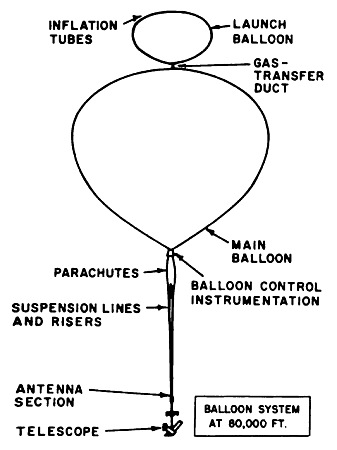Purpose of the flight and payload description
This flight was part of the testing phase of Stratoscope II one of the most sophisticated balloon-borne telescope systems ever flown. It's goal was to photograph planets and stellar nebulae from Earth's stratosphere with previously unseen precision in an effort that can be viewed in perspective as a distant precursor to the Hubble Space Telescope. The instrument was a 36-inch telescope, designed to permit greatly improved nocturnal observation of planetary and stellar objects with high resolution. The instrument weighed near 8.000 lbs.
In planning Stratoscope II, one of the prime considerations was to construct a balloon strong enough to lift such a heavy weight to the required altitude of 80,000 feet. Polyethylene film, commonly used for balloons, was then limited to a load-carrying capacity of about 4,000 pounds, and thus was unsatisfactory for the project. To meet this problem, the G.T. Schjeldahl Company of Northfield, Minnesota under contract to ONR, developed a reinforced laminated plastic film having high tensile strength and tear resistance. Schjeldahl also developed, a new balloon system capable of lifting the heavy telescope payload off the ground quickly while remaining unbuffeted by ground winds as high as 15 knots.
As we can see in the scheme at left (click for more details) the system employed two balloons -a small one and a large one, with the former mounted on top of the latter. The small balloon was composed of a 0.5 mil Mylar and dacron laminate called S-12 with a volume of 250,000 cubic feet. The main balloon consisted of a 0.3 mil Mylar and dacron material known as S-11 with a volume of 5,250,000 cubic feet. The two balloons were connected by a 2-1/2 foot metal tube, 3 feet in diameter, attached to a 3-foot hole in each balloon.
The launch balloon was designed to hold enough helium to lift the payload to altitude. In preparation for the flight the launch balloon was inflated while connected to the main balloon which remained in its shipping box. Once the smaller balloon was full, it was attached to a cable and allowed to ascend slowly, lifting the main balloon (which was snugly wrapped in a plastic sheath), until the entire system stood erect above the telescope. Wrapping the uninflated main balloon prevented its ''sailing'' and sweeping the payload out horizontally. Immediately before launch the entire system towered over 600-feet tall. At launch an explosive charge released the restraining cable and the balloon took-off gently, without sway or rotation. Once the balloon left the ground, the protective sheath was ripped from the main balloon. As the balloon ascended the change in atmospheric pressure with altitude induced a flow of gas from the launch balloon into the main balloon. At 30.000 feet both were fully inflated.
Details of the balloon flight
Balloon launched on: 1/16/1961
Launch site: Goodfellow Air Force Base, San Angelo, Texas, US
Balloon launched by: G.T. Schjeldahl Co.
Balloon manufacturer/size/composition: Zero Pressure Balloon Schjeldahl - 3.000.000 cuft (Mylar)
End of flight (L for landing time, W for last contact, otherwise termination time): 1/16/1961
Landing site: Launch balloon burst
The test failed due to the burst of the launch balloon
External references
- Project Stratoscope II Summary in Flight Summary Log, Winzen Research Inc. report (1963)
6825If you consider this website interesting or useful, you can help me to keep it up and running with a small donation to cover the operational costs. Just the equivalent of the price of a cup of coffee helps a lot.


